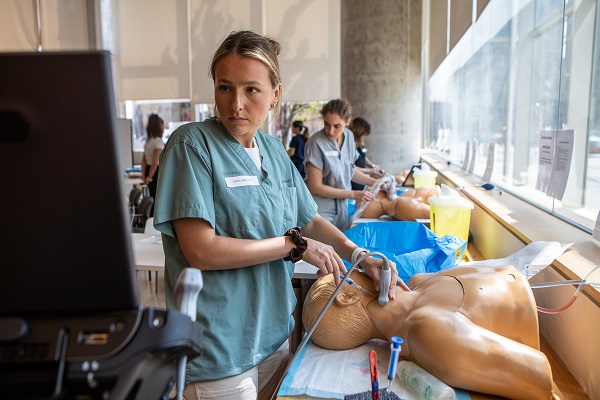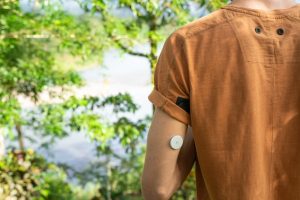Preparing for rare emergency events

By Olivia Lavery
Inside St. Michael’s Hospital a tense scene is unfolding.
“The patient is a 32-year-old pregnant female,” Dr. Emily Austin, an emergency physician and trauma team leader, announces to the room. “Five minutes out.”
A group of medical residents, emergency nurses and respiratory therapists close ranks around a hospital bed, huddling together to split up duties.
“I’ll lead,” says one. The others nod.
The patient arrives and the clinicians begin to move. One steps onto a bedside foot stool and starts chest compressions, another picks up a scalpel. They call out information to each other, listing steps aloud and ordering more intravenous medication. Someone verbally marks each tense minute as it passes.
The procedure they’re conducting is called a resuscitative hysterotomy, a rare event when an emergency C-section must be performed on a patient in cardiac arrest. Everything about the scene seems real – the intensity, the sounds, the whirring machines – and that’s exactly how Unity Health Toronto’s simulation program wants it to be.
The patients – both mother and baby – are simulation “manikins”, and the scenario has been set up by highly trained instructors, simulation educators and specialists who are guiding a group of interprofessional clinicians through real-time training for emergencies they could encounter in their careers. It’s all part of a specially designed critical care skills training day.
Every year St. Michael’s hosts this day for senior University of Toronto emergency medicine residents, nurses and respiratory therapists in its state-of-the-art simulation centre. More than 300 participants have completed the training. They practice a variety of skills like inserting chest tubes, handling difficult or obstructed airways, and even run through complicated emergency scenarios like the resuscitative hysterotomy and emergency thoracotomy.
“These procedures are known as high acuity, low occurrence – or HALO – events,” says Dr. Andrew Petrosoniak, an emergency physician at St. Michael’s and the co-director of skills day alongside Dr. Sara Gray, emergency physician and intensivist.
HALO procedures are hard to prepare for because they happen so infrequently, meaning medical professionals often don’t get a chance to see what they look like in real life before having to respond to one.
“When I was training we didn’t have such comprehensive simulation sessions like this,” says Petrosoniak. “Of course there were ways to practice skills, but your first time really experiencing or performing that procedure would be when it was actually happening.”

Critical care skills day, now in its ninth year, is a huge draw for residents across Toronto, as well as nurses and respiratory therapists from St. Michael’s, to hone their abilities. The Simulation Program team goes to great lengths to make it as educational and realistic as possible. Simulation Specialist Sue Zelko, who played a key role in the design and flow of the day, said the team spent almost 40 hours putting together props for the simulated scenarios – using materials like yoga mats, water balloons and outdoor furniture cushions to create realistic models.
Participants get a chance to learn from emergency medicine, critical care and trauma surgery experts, and get hands-on practice that will prepare them for difficult cases down the line.
Dr. Evelyn Dell, now an emergency physician and trauma team leader at St. Michael’s, attended skills day as a resident. That year trainees practiced a procedure called a cricothyrotomy, when a doctor has to make an incision in a patients’ throat to open up the airway. Dell found herself having to perform one in an emergency situation within a year of the training. As a staff physician, she also performed the procedure once more with a positive outcome for the patient. She says skills day gave her the confidence and comfort to handle both cases.
“The training helped me develop an element of muscle memory for procedure performance,” says Dell. “I believe it also reduces error and streamlines decision making.”
The St. Michael’s emergency department is one of only two Level I trauma centres in Toronto. The program is working towards being accredited as a Level I centre by the American College of Surgeons, a designation that has only been achieved by one other hospital outside of the United States. Events like skills day are part of the culture that makes St. Michael’s such an excellent place to be treated for emergencies and trauma.
Back in the simulation centre, the resuscitative hysterotomy ends. The baby sits safely on a small delivery table, swaddled in a white blanket and the manikin mother lies supine on the bed.
Dr. Austin applauds the group.
“That was really, really great,” she says, met with smiles from the trainees who exchange high-fives and pat each other on the back. Then she’s back to teaching mode. “Now let’s talk about physiological changes in pregnancy.”
Olivia Lavery is a Communications Advisor at Unity Health.








